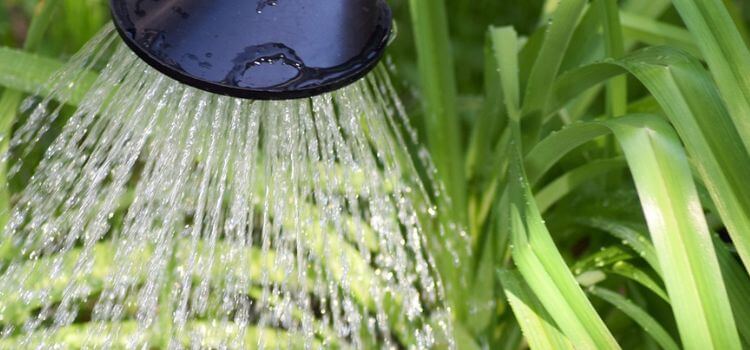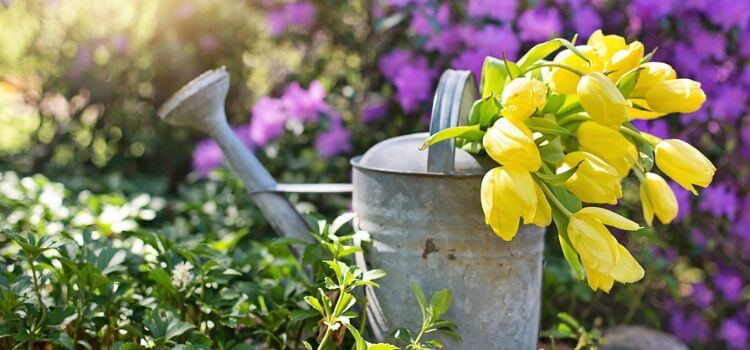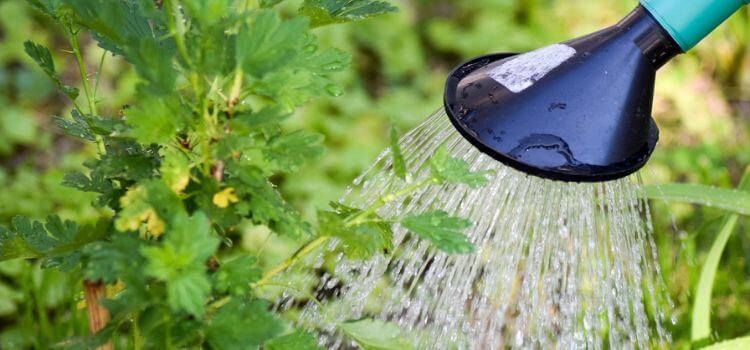As an Amazon Associate, I earn from qualifying purchases.
Outdoor plants should be watered once or twice a week. Water deeply to ensure roots receive adequate moisture.
Proper watering is crucial for the health of outdoor plants. The frequency depends on various factors, such as climate, soil type, and plant species. Overwatering can lead to root rot, while underwatering can cause plants to wilt and die. Early morning or late evening is the best time to water, as it minimizes evaporation.
Consistent watering ensures plants remain healthy and thrive throughout the growing season. Mulching can help retain soil moisture and reduce the need for frequent watering. Regularly check soil moisture by inserting a finger into the soil up to the second knuckle. Adjust watering habits based on weather conditions and plant needs.
Factors Affecting Watering Frequency
Watering outdoor plants can be tricky. How often you water them depends on many factors, which can affect how much and how often your plants need water. Let’s look at some of these key factors that influence watering frequency.

Climate
The climate in your area plays a huge role in how often you should water your outdoor plants. In hot and dry climates, plants need more water, while in cooler and wet climates, they need less.
Here’s a simple guide:
- Hot and Dry: Water your plants every day or every other day.
- Cool and Wet: Water your plants once or twice a week.
- Moderate: Water your plants two to three times a week.
Also, consider the season. During summer, plants need more water. In winter, they need less. Windy conditions can dry out soil faster. So, you should water more often when it’s windy.
Plant Type
Different plants have different water needs. Succulents and cacti need less water while flowering plants and vegetables need more.
Consider these plant types:
- Succulents and Cacti: Water once every two weeks.
- Flowering Plants: Water two to three times a week.
- Vegetables: Water every day or every other day.
Trees and shrubs usually need deep watering once a week. However, ground covers might have a high water demand and need frequent watering. Always check the specific needs of your plant.
Soil Type
Soil type is another important factor. Sandy soil drains quickly and needs more frequent watering. Clay soil holds water longer and needs less frequent watering.
Here’s a quick guide:
- Sandy Soil: Water more often, maybe every day.
- Clay Soil: Water less often, maybe once a week.
- Loamy Soil: Water two to three times a week.
By understanding your soil type, you’ll be able to water your plants correctly, ensuring their health and growth. So, test your soil by checking how quickly water drains after a rain. If it drains fast, it’s sandy. If it drains slowly, it’s clay. This knowledge will empower you as a gardener.
Signs Of Underwatering
Outdoor plants need the right amount of water to stay healthy. Knowing when to water them is crucial. One key aspect is recognizing the signs of underwatering. This helps you give your plants the care they need.
Wilting Leaves
Wilting leaves are one of the most apparent signs of underwatering. When plants don’t get enough water, their leaves start to sag. This happens because the plant cells lose water and pressure, causing the leaves to lose their firmness. Wilting can occur during the hottest parts of the day. If the leaves don’t perk up after the sun sets, it’s a clear sign your plant needs water.
Here are some common symptoms of wilting leaves due to underwatering:
- Drooping leaves that look lifeless.
- Yellowing leaves starting from the edges.
- Crispy and dry leaf tips.
Addressing wilting leaves quickly can save your plant. Water thoroughly until the soil feels moist, but not soggy. Repeat this process until the leaves regain their firmness. It’s also helpful to water plants early in the morning. This gives them enough time to absorb water before the sun gets too hot.
Dry Soil
Dry soil is another clear indicator of underwatering. Soil that lacks moisture can’t support healthy plant growth. To check if your soil is dry, stick your finger about an inch into the ground. If it feels dry, your plants need water.
Consider these signs of dry soil:
- Cracks on the soil surface.
- Soil pulling away from the edges of the pot or garden bed.
- Dusty texture when touched.
Maintaining the proper soil moisture is essential. Use a moisture meter to clarify the soil’s water content. For most outdoor plants, the soil should be moist but not soggy. Mulching can also help retain soil moisture. It reduces evaporation and keeps the soil cool.
Here’s a simple table to guide your watering schedule based on soil moisture:
| Soil Condition | Watering Frequency |
|---|---|
| Very Dry | Water Daily |
| Dry | Water Every 2 Days |
| Moist | Water Every 3-4 Days |
Monitoring soil moisture and watching for wilting leaves can keep your outdoor plants hydrated and healthy.
Signs Of Overwatering
How often should you water outdoor plants? This question is vital for gardeners. Overwatering is a common mistake that can harm plants. Understanding the signs of overwatering is critical to maintaining healthy plants. This section will explore two significant signs: yellowing leaves and mould growth.

Yellowing Leaves
Yellowing leaves are a primary sign of overwatering. When plants receive too much water, their roots can’t breathe. This lack of oxygen causes leaves to turn yellow. Look for the following signs:
- Pale, yellow leaves appear on the lower part of the plant.
- Wilting, even when the soil is moist.
- Soft, mushy stems that feel weak.
These symptoms indicate the roots are struggling. To confirm overwatering, check the soil. Stick your finger an inch deep into the soil. If it’s wet, you need to reduce watering. Proper drainage is essential. Ensure your plants are in well-draining soil. Here’s a quick guide to checking soil moisture:
| Soil Condition | Action Needed |
|---|---|
| Wet and soggy | Reduce watering |
| Dry and crumbly | Increase watering |
| Moist but not wet | Ideal condition |
Yellowing leaves are a clear sign that your plants need attention. The first step is to adjust your watering schedule to ensure that your plants are receiving the right amount of water. Remember to avoid watering during rainy days and use a rain gauge to track natural precipitation.
Mould Growth
Mold growth is another sign of overwatering. Excess water creates a damp environment. Mould thrives in such conditions. You may notice the following:
- White or grey fuzzy patches on the soil surface.
- Musty odour around the plant area.
- Black spots on leaves or stems.
Mold can harm plant health. It indicates that the soil stays too wet. To prevent mould, ensure proper air circulation. Space your plants appropriately. Consider using a fan if the area is enclosed. Here are some tips for managing mold growth:
- Remove affected leaves and stems immediately.
- Adjust your watering schedule.
- Use a fungicide if necessary.
- Improve soil drainage with organic matter like compost.
Mould can also be prevented by watering early in the morning. This allows the soil to dry out during the day. Monitor your plants regularly for any signs of mould. Keeping plants healthy requires the right balance of water.
General Guidelines For Watering Outdoor Plants
Watering outdoor plants can be tricky. Knowing how often to water them ensures they stay healthy and thrive. Here are some general guidelines for watering outdoor plants. Understanding these basics will help you keep your garden lush and green.
Morning Watering
Watering your plants in the morning is the best practice. Early morning watering allows the water to soak into the soil before the day’s heat. This helps plants absorb the moisture they need to stay hydrated throughout the day. Here are some key points:
- Watering in the morning reduces evaporation.
- It helps prevent fungal growth by allowing the foliage to dry during the day.
- Morning watering keeps plants hydrated during the hottest parts of the day.
Let’s look at some benefits in a table:
| Benefit | Explanation |
|---|---|
| Reduced Evaporation | Watering before the sun is high prevents water loss. |
| Fungal Prevention | Leaves dry out faster, reducing the risk of fungi. |
| Better Hydration | Plants absorb water better when it is cooler. |
Consistent morning watering sets a routine for your plants, helping them grow strong and healthy.
Deep Watering
Deep watering ensures the roots get enough moisture. This method involves watering plants slowly and thoroughly. Here are some reasons why deep watering is essential:
- Encourages profound root growth.
- Increases drought resistance.
- Prevents shallow root systems.
Consider these tips for deep watering:
- Water slowly lets the soil absorb moisture deeply.
- Ensure water reaches a depth of at least 6-8 inches.
- Use a soaker hose or drip irrigation system for better results.
Deep watering is essential for trees and shrubs. Their roots need to go deep to find nutrients and water. Regular deep watering promotes healthier, more resilient plants.
Following these guidelines lets you keep your outdoor plants well-watered and healthy. Remember, the key is to water deeply and consistently.
Watering Frequency For Common Outdoor Plants
Watering outdoor plants correctly is crucial for their growth and health. The proper watering frequency varies based on the type of plant. Understanding the specific needs of each plant type ensures they thrive and flourish. Let’s explore the ideal watering frequency for common outdoor plants.
Flowering Plants
Flowering plants need the right amount of water to bloom beautifully. Overwatering or underwatering can harm them. Here are some guidelines:
- Roses: Water deeply twice a week. Ensure the soil is moist but not soggy.
- Sunflowers: These need water once a week. They prefer dry soil between watering.
- Petunias: Water daily during hot weather. Keep the soil consistently moist.
Creating a watering schedule helps maintain consistency. Before watering, check the soil’s moisture level. Use a moisture meter, or touch the soil with your fingers.
| Plant | Watering Frequency |
|---|---|
| Roses | Twice a week |
| Sunflowers | Once a week |
| Petunias | Daily in hot weather |
Vegetables And Herbs
Vegetables and herbs have different watering needs based on their type and growth stage. Proper watering ensures a bountiful harvest. Here are some examples:
- Tomatoes: Water deeply three times a week. Consistent moisture prevents cracking and blossom end rot.
- Basil: This herb prefers moist soil. Water every other day, ensuring the soil stays damp.
- Carrots: Water once a week, but make sure the water reaches the roots. Deep watering encourages strong root growth.
Consider using a drip irrigation system for vegetables and herbs. This provides consistent moisture without overwatering. Mulching around the plants helps retain soil moisture.
Adjusting Watering Frequency Throughout The Year
Watering outdoor plants can be tricky. Understanding how often to water them is critical to maintaining their health. Adjusting watering frequency throughout the year is vital. Different seasons and weather conditions require different watering schedules. This guide will help you keep your plants happy and hydrated all year round.

Seasonal Changes
Plants need different amounts of water in each season. Spring often brings new growth, which requires more water to support. Water your plants more frequently as the days get warmer.
- In spring, water your plants every 3-4 days.
- Increase watering should be increased every 2-3 days in summer due to higher evaporation rates.
- Fall requires less water as temperatures drop. Water every 5-7 days.
- In winter, plants need little water. Water once every 2-3 weeks.
With this guide, you can confidently adjust your watering frequency throughout the year, ensuring your plants are always healthy and hydrated. Remember, understanding the unique needs of each season is the key to successful gardening.
Adjusting Watering Frequency Throughout The Year
Watering outdoor plants can be tricky. Understanding how often to water them is critical to maintaining their health. Adjusting watering frequency throughout the year is vital. Different seasons and weather conditions require different watering schedules. This guide will help you keep your plants happy and hydrated all year round.
Seasonal Changes
Plants need different amounts of water in each season. Spring often brings new growth, which requires more water to support. Water your plants more frequently as the days get warmer.
- In spring, water your plants every 3-4 days.
- Increase watering should be increased every 2-3 days in summer due to higher evaporation rates.
- Fall requires less water as temperatures drop. Water every 5-7 days.
- In winter, plants need little water. Water once every 2-3 weeks.
Tools And Techniques For Efficient Watering
Watering outdoor plants is a crucial task. Proper watering is the key to keeping plants healthy and vibrant. By using the right tools and techniques, you cannot only save time and water but also ensure the well-being of your plants.
Drip Irrigation Systems
Drip irrigation systems are a top choice for efficient watering. They deliver water directly to the plant roots. This method reduces water waste and promotes healthy growth.
Benefits of Drip Irrigation Systems:
- Water Efficiency: Water reaches the roots directly. Less water evaporates.
- Time-Saving: Automate the system to water plants at specific times.
- Healthier Plants: Consistent moisture levels prevent diseases.
Components of a Drip Irrigation System:
| Component | Function |
|---|---|
| Drip Line | Transports water to plants |
| Emitters | Release water at controlled rates |
| Filter | Prevents clogging |
| Timer | Automates watering schedule |
Installation Tips:
- Lay out the drip lines near plant bases.
- Install emitters every 12-18 inches.
- Connect the system to a timer.
- Test the system to ensure proper water flow.
Mulching
Mulching is another effective watering technique. It involves covering the soil with organic or inorganic materials. Mulch helps retain moisture and reduce water evaporation.
Benefits of Mulching:
- Moisture Retention: Keeps soil moist for more extended periods.
- Weed Control: Reduces weed growth by blocking sunlight.
- Soil Health: Organic mulch breaks down and enriches the soil.
Types of Mulch:
| Type | Material |
|---|---|
| Organic | Wood chips, straw, leaves |
| Inorganic | Gravel, plastic, rubber |
Application Tips:
- Spread mulch 2-4 inches thick around plants.
- Keep mulch away from plant stems to prevent rot.
- Replenish mulch as it decomposes.
Both drip irrigation systems and mulching can transform your garden. They save water, time, and effort. Use these techniques to keep your outdoor plants thriving.
Frequently Asked Questions
Should You Water Outdoor Plants Daily?
No, it would help if you did not water outdoor plants daily. Most plants need watering 2-3 times a week. Overwatering can harm plants. Adjust based on weather and soil type.
Can You Overwater An Outdoor Plant?
Yes, you can overwater an outdoor plant. Excess water can suffocate roots, leading to root rot and poor plant health.
How Often Should You Water Outdoor Plants In Hot Weather?
In hot weather, water outdoor plants daily. Ensure soil remains moist but not soggy. Morning is the best time.
How To Tell If Outdoor Plants Need Water?
Check soil moisture by inserting your finger 1-2 inches deep. Water if the soil feels dry. Wilted leaves, dry topsoil, and slow growth also indicate thirst.
Conclusion
Proper watering is crucial for healthy outdoor plants. Monitor soil moisture and adjust based on weather conditions. Consistent care ensures vibrant growth and resilience. Remember, each plant has unique needs, so observe and adapt.

